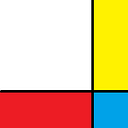Raffaello: Nomadism KOL
拉斐尔·桑西(Raffaello Santi)是“文艺复兴三杰”中最为年轻的一位,他的父亲是一位宫廷画家,他从小在父亲的熏陶下,产生了对艺术的浓厚兴趣,也表现出了极强的天赋。之后,拉斐尔师从彼得罗·佩鲁吉诺(Pietro Perugino),向弗拉·巴托罗米奥(Fra Bartolommeo)学习了着色技巧,研究了米开朗基罗和达·芬奇的作品……他博采众长,吸取前代艺术大师画作中的精髓,最终成为一个综合性的艺术天才。
Raffaello Santi is the youngest of the “Three Renaissance”. His father is a court painter, and he grew up in the father’s influence, has developed a keen interest in art, but also showed a solid talent. After that, Raphael studied the coloring techniques from Pie Barolommeo and studied the works of Michelangelo and Leonardo da Vinci from Pietro Perugino …… He draws on all strengths, absorbs the essence of the paintings of the previous generation of masters, and eventually becomes an absolute artistic genius.
学术上有这样一个专有名词“拉斐尔的四个房间”,这是指拉斐尔用壁画为罗马教皇宅邸的四个房间所做的装饰。其中,他在第一个房间,即教皇的签字大厅,留下的壁画《雅典学院》又被称为“文艺复兴第一画”。如此盛名并非因为画家的作画技巧多高,而是这幅画准确表达了文艺复兴想要传达的人文精神。
Academically, there is term as “the four rooms of Raphael”, which refers to the decoration made by Raphael for the four rooms of the papal mansion with frescoes. Among them, he left the mural “Athens Academy” in the first room, the Pope’s signature hall, also known as “the first painting of the Renaissance”. The reason why it is so influential is not because of the painter’s skill in painting, but the art accurately expresses the humanistic spirit that the Renaissance wants to convey.
雅典学院是指,在哲学家柏拉图的主张下,历史上第一座供各领域人才交流思想的“学校”。拉斐尔使用回忆这一“黄金时代”的形式来表达对未来的向往。
The Academy of Athens refers to the first “school” in history under which the philosopher Plato advocated the exchange of ideas among talents in various fields. Raphael uses the form of recalling this “Golden Age” to express his yearning for the future.
可以看到画面中的聚集了七十七位来自不同时代、不同地域、不同领域的学者,他们正在自由且热烈地讨论着,气氛高涨,如同在举行某个盛大的庆典。背后是一座庄严的拱门,两边的壁龛里分别是智慧女神雅典娜(左)以及音乐之神阿波罗(右)的雕像,线性透视的技巧让这一场所拥有极强的纵深感,更显庄严神圣。
There are 77 scholars from different eras, different regions, and various fields gathered in the picture. They are discussing freely and enthusiastically, and the atmosphere is high, just like holding a grand celebration. Behind is a solemn arch. On both sides of the niches are statues of the goddess of wisdom Athena (left) and the god of music Apollo (right). Solemn and sacred.
拉斐尔不知古人的相貌,因而将文艺复兴时期的大师画入了画中,与古代的大师对应起来。根据知乎“混乱博物馆”的解答,能够确定的人物有有二十一位:
Raphael did not know the appearance of the ancients, so he painted the Renaissance masters into the painting, corresponding to the ancient masters. According to the answers to the “Museum of Chaos”, there are twenty-one characters that can be identified:
按从1–22的顺序,这些人物分别是:亚历山大大帝(建立了亚历山大帝国),安提西尼(犬儒学派创始人)、色诺芬(著有《希腊史》、《斯巴达政体论》等著作)、苏格拉底(西方哲学三贤)、以达芬奇为原型的柏拉图(西方哲学三贤)、以米开朗基罗为原型的亚里士多德(西方哲学三贤)、季蒂昂的芝诺(斯多葛学派哲学家)、琐罗亚斯德(琐罗亚斯德教创始人)、埃利亚的芝诺(提出芝诺悖论)、伊比鸠鲁(伊比鸠鲁学派创始人)、德谟克里特(提出原子是构成世界的最小微粒)、阿维洛伊(伊斯兰哲学家)、毕达哥拉斯(毕达哥拉斯学派创始人)、系帕提亚(罗马帝国时期的女数学家)、巴门尼德(提出“存在”问题)、赫拉克利特(流变论的代表人物)、第欧根尼(犬儒学派代表人物)、阿基米德(古希腊数学家、物理学家)、布拉曼特(文艺复兴时期建筑师)、托勒密(罗马帝国时期的天文学家、地理学家)、拉斐尔。
In order from 1–22, these characters are: Alexander the Great (established the Alexander empire), Antisini (founder of the cynicism), Xenophon (author of “History of Greece”, “Spartan Theory of Regime” “And other works), Socrates (three philosophers of western philosophy), Plato (the three philosophers of western philosophy) based on Leonardo da Vinci, Aristotle (three sages of western philosophy) based on Michelangelo, Zeno of Titian (philosopher of the Stoic school), Zoroastrian (founder of Zoroastrianism), Zeno of Elia (proposing the Zeno paradox), Iberoglu (Ibi The founder of Kulu School), Democritus (proposing that atoms are the smallest particles that make up the world), Aviloi (Islamic philosopher), Pythagoras (founder of Pythagoras School), Department Parthia (female mathematician during the Roman Empire), Parmenides (proposing “existence”), Heraclitus (representative of rheology), Diogenes (representative of cynicism), Arab Kimid (ancient Greek mathematician and physicist), Bramante (Renaissance architect), Ptolemy (astronomer, geographer during the Roman Empire), Raphael.
可以看出画面中的人物虽然复杂,但拉斐尔依然很好的处理了他们的关系,每个人神态、动作各异,且十分生动。他的人物塑造的温厚圆润,整幅作品流露出了安宁、和谐、饱满的气质。
Although the characters in the picture are complicated, Raphael still handles their relationship very well. Everyone has different looks and movements and is very vivid. His characters are gentle and round, and the whole work shows a peaceful, harmonious, and full temperament.
Reference: http://cnwmw.blogspot.com/2018/11/blog-post_969.html
